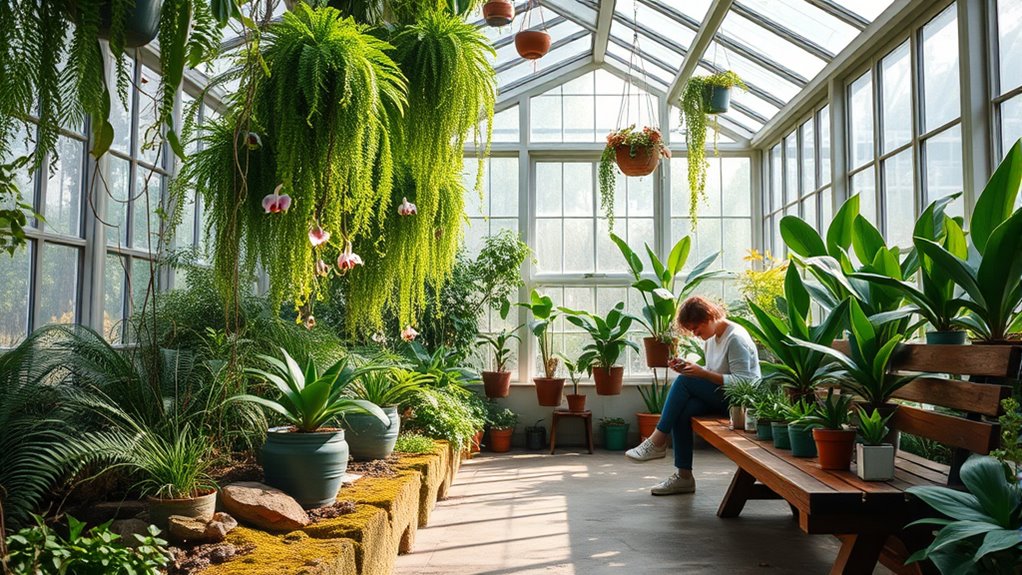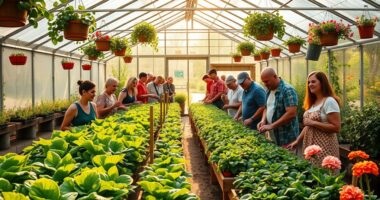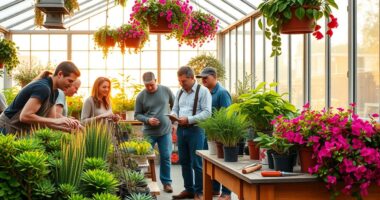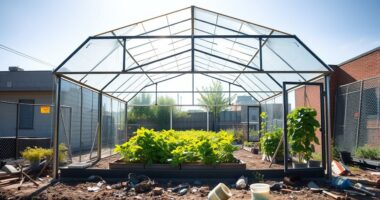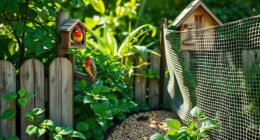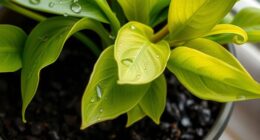Greenhouse therapy lets you enjoy gardening in a controlled space that promotes healthier plants and your well-being. By managing conditions like light, temperature, and humidity, you create a calming environment that reduces stress and boosts your mood. Tending to plants in this stable setting fosters mindfulness, patience, and emotional balance. As your plants thrive, their healing benefits grow too—so keep exploring to discover even more ways greenhouse therapy supports your overall wellness.
Key Takeaways
- Greenhouse therapy creates a controlled environment that optimizes plant growth and promotes emotional well-being.
- Gardening indoors reduces stress and fosters meditative focus through tactile engagement with plants.
- The stable conditions support faster plant healing, enhancing their healing properties and medicinal benefits.
- Interacting with lush greenery in a greenhouse elevates mood and triggers the release of feel-good hormones.
- Engaging in greenhouse gardening promotes mindfulness, patience, and overall holistic health for both plants and people.
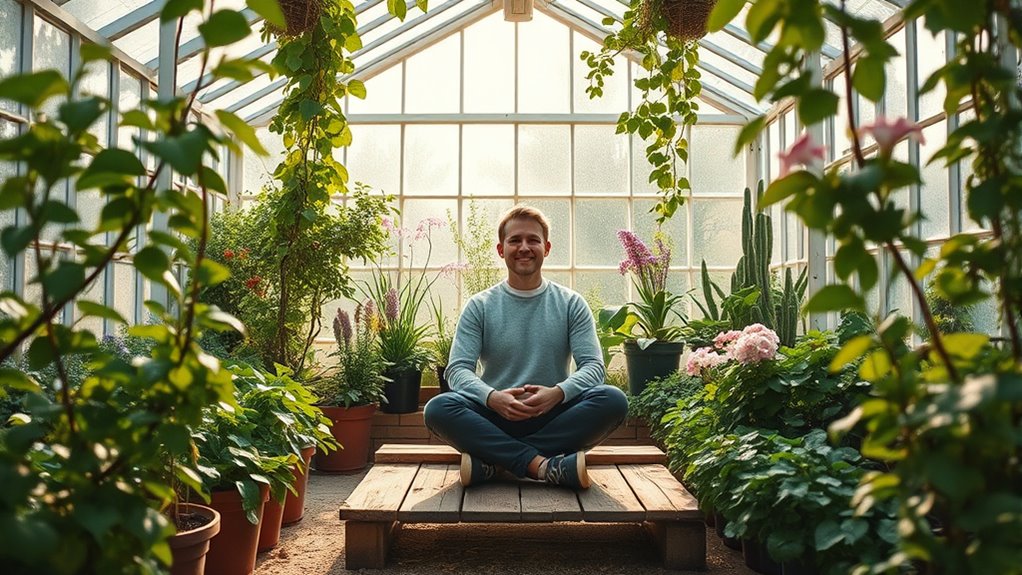
Have you ever wondered how controlled environments can boost plant growth and healing? Greenhouse therapy leverages the power of a carefully managed space to foster not only healthy plants but also your well-being. When you step into a greenhouse, you’re entering a sanctuary designed to optimize conditions like temperature, humidity, and light. This controlled environment enhances plant-based healing by helping plants recover from stressors or pests more efficiently, making them healthier and more vibrant. As a result, your connection to these thriving plants can be deeply therapeutic, encouraging a sense of calm and balance.
Greenhouse environments promote plant health and personal well-being through controlled, therapeutic growth and healing.
Gardening under glass offers a unique opportunity to experience stress reduction firsthand. Unlike outdoor gardening, which relies on unpredictable weather and pests, a greenhouse provides a stable environment that minimizes disruptions. This predictability allows you to focus solely on nurturing your plants without the worry of sudden setbacks. As you tend to the greenery, you naturally enter a meditative state, grounding yourself in the simple act of caring for living things. This process of nurturing can be incredibly soothing, promoting mental clarity and emotional stability. The tactile experience of handling soil and plants in a controlled space also helps you disconnect from daily stressors, replacing worry with a sense of accomplishment and peace.
Additionally, the environment within a greenhouse can support plant recovery and regeneration, making it easier for plants to heal and flourish, which in turn amplifies their therapeutic benefits. The benefits of greenhouse therapy extend beyond stress reduction. The consistent conditions in a greenhouse support faster growth and more vigorous plant development, which can amplify the healing properties of certain medicinal plants. When these plants thrive, they become more potent sources for herbal remedies, teas, or natural treatments that contribute to your overall health. The environment also encourages mindfulness and patience, giving you time to slow down and appreciate the intricate process of growth and healing. This focused attention can reduce feelings of anxiety and foster a sense of mastery and purpose.
In addition, being surrounded by lush greenery within a greenhouse can elevate your mood and boost your immune system. The act of caring for plants, combined with the calming atmosphere, promotes the release of feel-good hormones like serotonin. As you observe the vibrant life around you, you feel more connected and centered. The controlled setting not only maximizes plant health but also creates an ideal space for your personal well-being. Whether you’re simply enjoying the serenity or actively cultivating your garden, greenhouse therapy offers a holistic approach that nurtures both your plants and your mind.
Frequently Asked Questions
Can Greenhouse Therapy Help With Severe Mental Health Conditions?
Greenhouse therapy can offer mental health benefits by providing a calming environment for therapeutic plant care. While it may not replace professional treatment for severe conditions, engaging in gardening under glass helps reduce stress, improve mood, and foster mindfulness. You’ll find that nurturing plants in a greenhouse creates a soothing routine, supporting mental wellness and offering a gentle, accessible way to boost emotional resilience.
What Are the Costs Associated With Starting Greenhouse Therapy?
Starting greenhouse therapy involves an initial investment for building or buying the greenhouse structure, along with essential equipment like heating, lighting, and watering systems. You’ll also need to budget for ongoing expenses such as utilities, maintenance, and plant supplies. Costs vary depending on the greenhouse size and technology used, but planning for both upfront costs and continuous expenses helps guarantee a successful and sustainable therapy experience.
Is Greenhouse Therapy Suitable for Children or Elderly Individuals?
Greenhouse therapy can be suitable for children and elderly individuals, especially when you create child-friendly gardens and guarantee elderly accessibility. You can design safe, easy-to-navigate spaces that promote engagement and relaxation. By incorporating low-maintenance plants and safety features, you help both age groups enjoy gardening’s therapeutic benefits. Tailoring the environment ensures everyone can participate comfortably, making greenhouse therapy an inclusive activity that boosts well-being across generations.
How Much Space Is Needed to Set up a Greenhouse Therapy Area?
The space requirements for setting up a greenhouse therapy area depend on your goals and available space. You’ll want enough room for plants, seating, and easy movement, so consider a layout that promotes accessibility and comfort. Typically, a small to medium-sized greenhouse of about 100 to 200 square feet works well. Focus on layout considerations like ventilation, light, and workspace to create a welcoming environment that supports healing and relaxation.
Are There Any Risks or Contraindications for Greenhouse Therapy?
Isn’t it wise to contemplate potential risks before diving in? You should be aware that greenhouse therapy might pose risks like plant allergies or pesticide exposure, especially if you’re sensitive or poorly informed. Always check for pesticide use and plant types. If you have allergies or respiratory issues, consult a healthcare professional beforehand. Being cautious ensures you enjoy the therapeutic benefits safely, turning a garden into a sanctuary rather than a source of trouble.
Conclusion
So, next time life feels overwhelming, forget therapy sessions or expensive retreats. Just grab your trowel, crawl into a greenhouse, and let the plants do the talking. Who knew that hiding among leafy greens could be the ultimate wellness hack? After all, nothing screams “mental clarity” quite like talking to tomatoes and arguing with orchids. So go ahead—ditch the couch, embrace the glass, and let your greenhouse be your new mental health guru.
